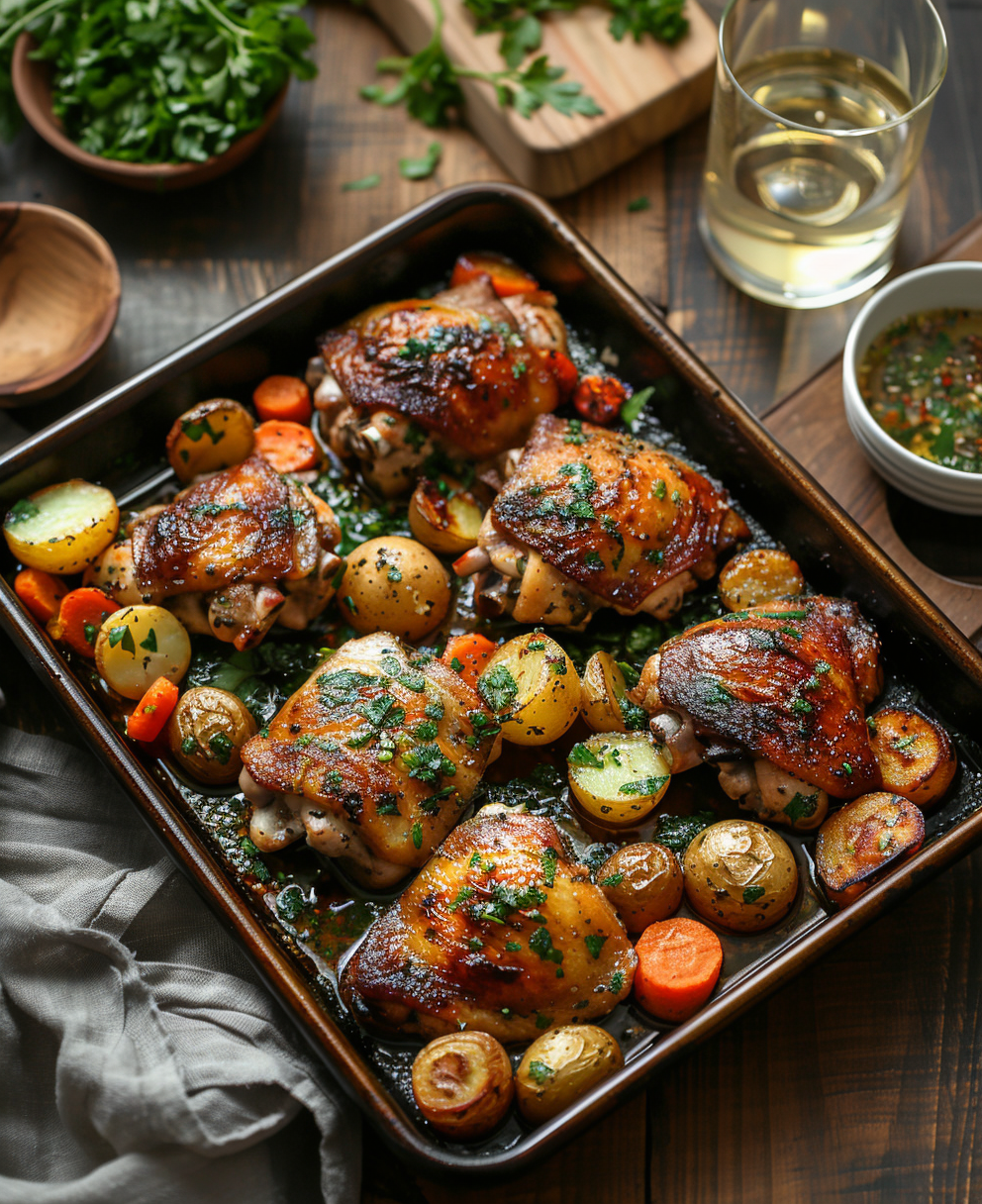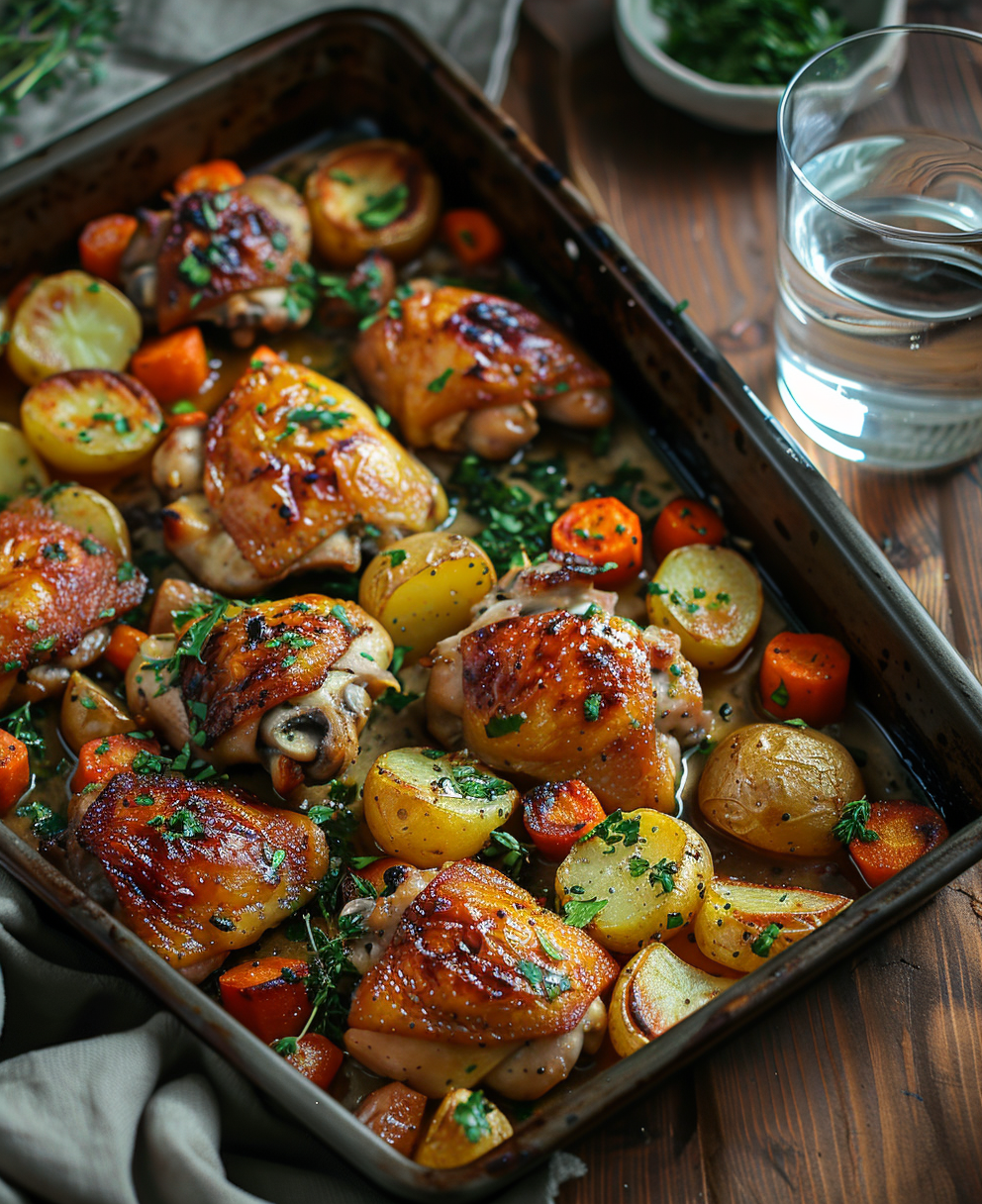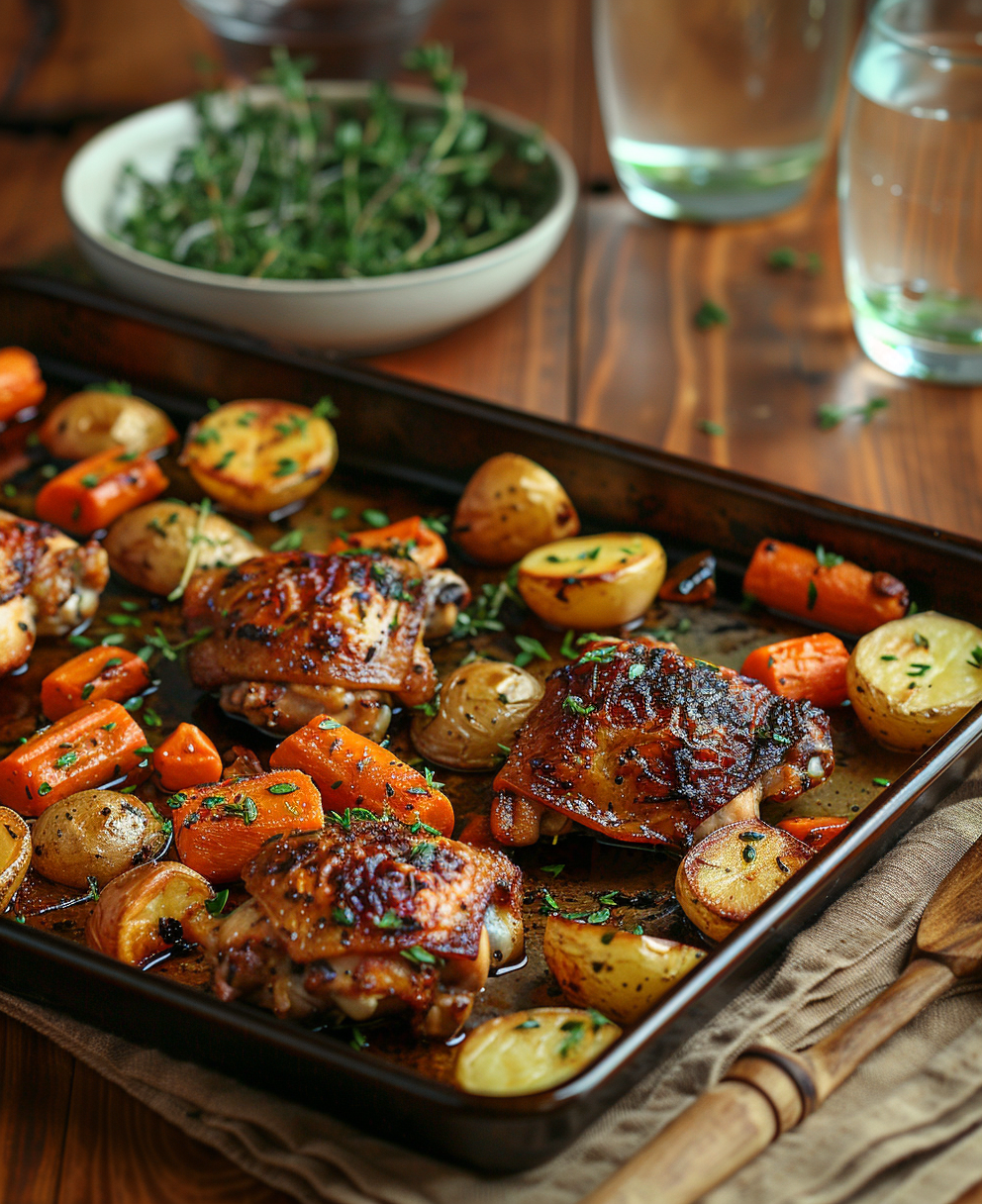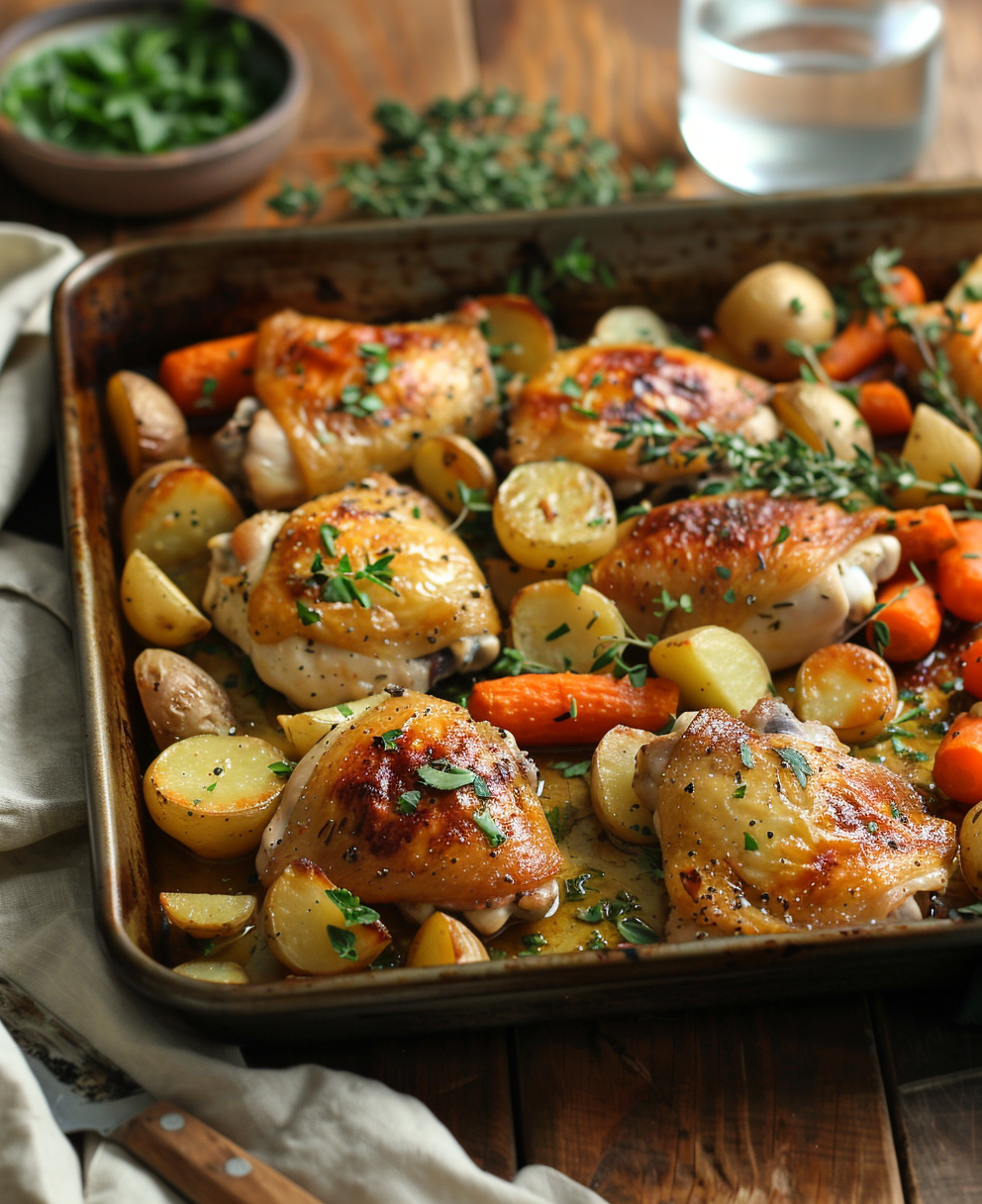Why I Love Simple, Flavorful Meals—and How Chicken Thigh Sheet Pan Recipes Became My Go-To
I’ll never forget the first time I made a chicken thigh sheet pan recipe. It was one of those chaotic weeknights where my to-do list felt endless. I grabbed some chicken thighs, tossed them with potatoes and veggies, and slid the whole thing into the oven. When I pulled it out, the smell alone told me I’d struck gold. Juicy, flavorful chicken thighs surrounded by perfectly roasted vegetables? That night, I realized simple meals could also be spectacular.
Since then, chicken thigh sheet pan recipes have become my secret weapon for busy evenings. They’re quick to prep, easy to clean up, and packed with flavor. Plus, chicken thighs are forgiving—hard to overcook and always moist. Unlike chicken breasts, which can dry out in a flash, thighs stay juicy even if you accidentally leave them in the oven a few extra minutes.
What makes chicken thighs so great for sheet pan cooking? Their versatility is unmatched. You can pair them with almost anything: sweet potatoes, broccoli, carrots, or even fruits like apples or oranges. The skin crisps up beautifully in the oven, locking in moisture while adding a layer of texture that’s hard to beat. Whether you’re feeding a family or just yourself, they’re a reliable choice.
Why Chicken Thighs Are My Favorite Protein
Let’s talk about why chicken thighs are my go-to protein. For years, I stuck to chicken breasts because that’s what everyone seemed to recommend. But after trying thighs, I realized how much juicier and more flavorful they are. Chicken breasts can turn dry and bland without careful attention, but thighs? They’re practically foolproof.
The best method for cooking chicken thighs, in my opinion, is roasting them on a sheet pan. The high heat caramelizes the edges and renders the fat from the skin, creating a crispy layer that’s downright irresistible. If you’ve ever wondered, “What is the best method for cooking chicken thighs?”, this is it. Roasting brings out their natural richness and pairs beautifully with almost any seasoning or side dish.
I discovered sheet pan recipes during a particularly hectic season of life. I was tired of spending hours in the kitchen only to end up with dishes piled high. One day, I decided to experiment. I tossed chicken thighs with olive oil, garlic, salt, and pepper, then added chunks of potato and broccoli. Forty minutes later, dinner was ready—and cleanup took less than five minutes. That’s when I knew I’d found something special.
How to Prep Your Sheet Pan for Perfect Results
Before we dive into seasoning and cooking, let’s talk about the basics: prepping your sheet pan. Trust me, this step makes all the difference. Start by lining your pan with parchment paper or aluminum foil. Not only does this prevent sticking, but it also saves you from scrubbing baked-on bits later. Easy cleanup is a game-changer, especially on busy nights.
A common question people ask is, “Do you cook chicken thighs skin side up or down in a sheet pan?” The answer is simple: skin side up. This allows the fat to render out slowly, creating that coveted crispy skin while keeping the meat tender underneath. Placing them skin side down might seem like a good idea, but it often leads to soggy results.
Now, let’s talk seasoning. Chicken thighs are incredibly versatile, so don’t be afraid to get creative. Here’s my go-to approach:
- Start with a base: Olive oil, salt, and pepper are non-negotiable. They form the foundation of flavor.
- Add aromatics: Garlic powder, onion powder, or fresh herbs like rosemary or thyme work wonders.
- Kick it up a notch: Paprika, cumin, or chili powder add depth and a hint of spice.
- Finish with acid: A squeeze of lemon juice or a splash of vinegar brightens everything up.
If you’re wondering how long you can cook chicken thighs in a pan, the answer depends on their size and whether they’re bone-in or boneless. Bone-in thighs typically take about 35–40 minutes at 400°F, while boneless thighs need closer to 25–30 minutes. Always check that the internal temperature reaches 165°F to ensure they’re safe to eat.
Another tip: Don’t overcrowd your sheet pan. Give each piece of chicken space to breathe. Crowding traps steam, which prevents the skin from crisping up. Spread things out, and you’ll be rewarded with golden, delicious results every time.
Finally, feel free to mix raw chicken and potatoes (or other veggies) on the same pan. Just make sure everything is cut into similar-sized pieces so they cook evenly. Tossing them together with oil and seasoning creates a cohesive dish where all the flavors meld beautifully.
With these tips in mind, you’re ready to tackle chicken thigh sheet pan recipes like a pro. Whether you’re a seasoned cook or a beginner, this method delivers consistent, crowd-pleasing results. And the best part? You’ll spend less time cleaning and more time enjoying your meal.
Top Chicken Thigh Sheet Pan Recipes to Try Tonight
Now that we’ve covered the basics, let’s dive into some mouthwatering chicken thigh sheet pan recipes. These are dishes I turn to time and time again because they’re simple, satisfying, and packed with flavor. Whether you’re cooking for one or feeding a crowd, these recipes will have dinner on the table in no time.
Garlic Herb Chicken Thighs with Roasted Vegetables
If there’s one recipe that screams comfort food while still being healthy, it’s this one. Garlic Herb Chicken Thighs with Roasted Vegetables is my go-to when I want something hearty but not overly complicated. The best part? You can toss raw chicken and potatoes in the same dish without a second thought. Just chop up some potatoes, carrots, and broccoli, and you’re halfway there.
I like to start by seasoning the chicken thighs generously with minced garlic, dried herbs like rosemary and thyme, olive oil, salt, and pepper. Then, I toss the veggies in the same mix—why dirty an extra bowl, right? Spread everything out on your sheet pan, making sure the chicken isn’t crowded. Pop it in the oven at 400°F for about 35 minutes, and voila: dinner perfection. If you’re looking for more veggie-heavy options, check out one pot vegetarian recipes for inspiration.
By the way, don’t skip the step where you flip the veggies halfway through cooking. It helps them get evenly roasted and caramelized. Trust me; those crispy edges are worth it.
Lemon Pepper Chicken Thighs with Asparagus
When spring rolls around, I crave lighter, brighter flavors—and Lemon Pepper Chicken Thighs with Asparagus fits the bill perfectly. There’s something about the zesty tang of lemon paired with tender asparagus that feels refreshing after a long winter of heavy meals.
This dish comes together in under an hour, which makes it ideal for busy weeknights. Start by rubbing the chicken thighs with a mix of lemon zest, cracked black pepper, garlic powder, and a drizzle of olive oil. Lay them skin side up on the sheet pan, then scatter trimmed asparagus spears around them. A quick squeeze of fresh lemon juice before serving adds a final burst of brightness. For more ideas like this, take a peek at sheet pan chicken recipes.
Funny enough, this combo always reminds me of picnics—even though I’m usually eating it indoors. Maybe it’s the vibrant colors or the fact that it’s so light yet filling. Either way, it’s become a springtime staple in my house.
BBQ Chicken Thighs with Sweet Potatoes and Brussels Sprouts
Here’s the thing: sometimes you just need a meal that feels indulgent, even if it’s secretly good for you. That’s where BBQ Chicken Thighs with Sweet Potatoes and Brussels Sprouts come in. This recipe is a crowd-pleaser every single time, thanks to its smoky-sweet flavors and cozy vibe.
To make this magic happen, slather your chicken thighs with your favorite barbecue sauce—I swear by a homemade version, but store-bought works too. Toss cubed sweet potatoes and halved Brussels sprouts with olive oil, smoked paprika, and a pinch of brown sugar for sweetness. Arrange everything on the pan, leaving space between pieces so they crisp up nicely. Roast at 400°F for about 40 minutes, basting the chicken with extra BBQ sauce halfway through.
The result? Juicy chicken coated in sticky, caramelized goodness, alongside perfectly roasted veggies. If you love bold flavors, you might also enjoy Hawaiian chicken sheet pan recipe, which brings tropical vibes to your dinner table.
Cooking Tips for Perfect Chicken Thighs Every Time
You’ve probably wondered, “How long can you cook chicken thighs in a pan?” Well, here’s the scoop: timing depends on whether you’re working with bone-in or boneless thighs. Bone-in thighs generally take 35–40 minutes at 400°F, while boneless ones cook faster, clocking in at 25–30 minutes. But honestly, I don’t rely solely on time—I use a meat thermometer to ensure accuracy.
Speaking of thermometers, let’s talk about doneness. Chicken thighs should reach an internal temperature of 165°F to be safe to eat. However, I often pull mine out at 160°F since the residual heat will bring them up to temp as they rest. Resting is crucial—it allows the juices to redistribute, ensuring juicy thighs instead of dry ones.
One mistake I see people make is overcooking their chicken. Remember, thighs are forgiving, but they’re not invincible. Keep an eye on them, especially if you’re using a particularly hot oven. Oh, and whatever you do, resist the urge to flip them constantly. Let them cook undisturbed so the skin gets nice and crispy.
Pairing Chicken Thighs with Complementary Ingredients
Balancing flavors is key to taking your chicken thigh sheet pan recipes from good to great. Pairing chicken thighs with seasonal veggies is a smart move—it ensures freshness and variety throughout the year. In fall, try roasted squash and kale. Winter calls for hearty root vegetables like parsnips and turnips. And in summer, cherry tomatoes and zucchini shine.
Raw chicken and potatoes in the same dish remain a classic combo, but don’t limit yourself. Experiment with different textures and tastes. For instance, adding a splash of balsamic vinegar to Brussels sprouts gives them a tangy kick that pairs beautifully with rich BBQ chicken. Or toss sweet potatoes with cinnamon and nutmeg for a warming autumn twist.
Sauces and marinades are another way to elevate your dish. A yogurt-based marinade with lemon and dill adds a Mediterranean flair, while soy sauce, ginger, and honey create an Asian-inspired glaze. If you’re feeling adventurous, explore sheet pan chicken thigh recipes for even more creative ideas.
Here’s a little secret: I almost always double the sauce or marinade. Half goes on the chicken before cooking, and the other half gets drizzled on top just before serving. It’s an easy way to boost flavor without much extra effort. Plus, who doesn’t love a saucy plate?
In the end, cooking with chicken thighs is all about flexibility and fun. Whether you stick to tried-and-true favorites or branch out with new combinations, you really can’t go wrong. So grab your sheet pan, fire up the oven, and let’s get cooking!
Common Mistakes to Avoid When Making Sheet Pan Meals
Let’s talk about the pitfalls of sheet pan cooking, because trust me, I’ve made my fair share of mistakes. Sheet pan meals are supposed to be simple, but a few missteps can turn them from golden and crispy to soggy and bland. Here’s what to watch out for so you don’t fall into the same traps I did.
First up: overcrowding. If you pile too much onto your sheet pan, you’re basically creating a steam room instead of a roasting zone. Steam is the enemy of crispy skin and caramelized veggies. Spread things out generously—give each piece of chicken and every veggie chunk some breathing room. Think of it like social distancing for your dinner ingredients. I learned this the hard way when I tried to cram an entire family-sized meal onto one small pan. Spoiler alert: it didn’t end well.
By the way, preheating your oven isn’t optional—it’s essential. I used to skip this step thinking, “Eh, it’ll heat up while the food’s in there.” Wrong. Starting with a hot oven ensures even cooking and helps achieve that perfect sear on the chicken thighs. Plus, it prevents uneven results where the outside is overcooked and the inside is still raw. Nobody wants that kind of dinner drama.
Another rookie mistake? Forgetting to season both sides of the chicken thighs. Sure, it’s tempting to just sprinkle spices on the top side and call it a day, but flipping them over and seasoning the underside makes all the difference. It adds depth to the flavor profile and ensures every bite is packed with goodness. I once served under-seasoned chicken to my family, and let’s just say the side-eye glances were real. Lesson learned: season generously, season thoroughly.
Funny enough, I also discovered that not all sheet pans are created equal. Thin, flimsy pans warp in high heat, which throws off cooking times and creates hotspots. Investing in a sturdy, heavy-duty sheet pan has been a game-changer for me. If you’re serious about mastering chicken thigh sheet pan recipes, treat yourself to a quality pan. Your future dinners will thank you.
Tips for Elevating Your Sheet Pan Game
Here’s the thing about sheet pan meals: they’re versatile, but sometimes versatility can feel overwhelming. Where do you start? How do you keep things interesting? Let me share a few tricks I’ve picked up along the way.
If you’re aiming for restaurant-worthy results, layer flavors strategically. Start by tossing your veggies in olive oil and spices, then roast them for 10–15 minutes before adding the chicken. This gives the vegetables a head start and prevents them from turning mushy. Once the chicken joins the party, everything finishes cooking together in harmony. It’s a small tweak, but it makes a big impact.
Speaking of tweaks, don’t shy away from experimenting with sauces. A drizzle of pesto or chimichurri after the dish comes out of the oven can elevate it instantly. One time, I topped my Lemon Pepper Chicken Thighs with a dollop of tzatziki, and it was like a flavor explosion in my mouth. Seriously, try it—you won’t regret it.
Oh, and here’s a pro tip: add fresh herbs right before serving. Basil, parsley, or cilantro sprinkled on top adds a pop of color and freshness that ties everything together. It’s these little details that make your meal feel special, even if it only took 40 minutes to prepare.
While we’re talking about details, consider texture. Pair soft, creamy elements like roasted sweet potatoes with something crunchy, like toasted nuts or seeds. The contrast keeps every bite exciting. Balance is key, whether it’s balancing flavors, textures, or colors.
By the way, I’m always on the lookout for new ideas, especially when life gets hectic. That’s why I love browsing through collections like easy weeknight dinners. They’re packed with inspiration for quick, satisfying meals that don’t skimp on taste. Whether you’re feeding picky kids or hosting friends, there’s something for everyone.
Frequently Asked Questions (FAQ)
How long can you cook chicken thighs in a pan?
Bone-in chicken thighs typically take 35–40 minutes at 400°F, while boneless ones need around 25–30 minutes. Always check that the internal temperature reaches 165°F for safe consumption.
Do you cook chicken thighs skin side up or down in a sheet pan?
Cook them skin side up to allow the fat to render and create crispy skin. Placing them skin side down often leads to soggy results.
Can you cook raw chicken and potatoes in the same dish?
Absolutely! Just make sure everything is cut into similar-sized pieces so they cook evenly. Tossing them together with oil and seasoning creates a cohesive dish.
What is the best method for cooking chicken thighs?
Roasting on a sheet pan is my top choice. It caramelizes the edges, renders fat for crispy skin, and pairs beautifully with nearly any seasoning or side dish.
Should I flip chicken thighs halfway through cooking?
No need to flip them constantly. Let them cook undisturbed to achieve crispy skin. Flipping too much interrupts the process.
Can I use frozen chicken thighs for sheet pan recipes?
It’s better to thaw them first for even cooking. Frozen thighs may release excess moisture, affecting texture and browning.
Why are my roasted veggies soggy?
Soggy veggies usually result from overcrowding the pan or using wet produce. Pat veggies dry and leave space between pieces for proper airflow.
What temperature should I set my oven for sheet pan meals?
400°F is ideal for most recipes. It’s hot enough to crisp the chicken skin and caramelize the veggies without burning them.
How do I prevent sticking on the sheet pan?
Line your pan with parchment paper or aluminum foil, or lightly grease it with oil. This minimizes cleanup and avoids sticking.
Can I prep sheet pan meals ahead of time?
Yes! Assemble everything except the sauce, cover, and refrigerate. When ready to cook, let it sit at room temp for 15 minutes before roasting.
A Final Thought
Sheet pan meals have saved me more times than I can count. On those nights when I think, “There’s no way I can pull dinner together,” I grab my trusty pan, toss in some chicken thighs, veggies, and spices, and let the oven do the work. It’s comforting knowing that simplicity doesn’t mean sacrificing flavor or satisfaction.
So go ahead, experiment with bold marinades, seasonal veggies, or unexpected sauces. There’s no wrong way to approach chicken thigh sheet pan recipes. Share your creations in the comments—I’d love to hear how you’re making this method your own. Happy cooking!

Chicken Thigh Sheet Pan Recipes
Ingredients
Equipment
Method
- Preheat the oven to 400°F (200°C).
- Line a sheet pan with parchment paper or aluminum foil for easy cleanup.
- In a bowl, season the chicken thighs with olive oil, minced garlic, salt, pepper, and dried herbs.
- Toss the potatoes, carrots, and broccoli with the same seasoning mixture.
- Spread the chicken and vegetables on the sheet pan, ensuring none are crowded.
- Roast in the oven for approximately 35-40 minutes for bone-in thighs or 25-30 minutes for boneless thighs, until the internal temperature reaches 165°F (75°C).
- Flip the vegetables halfway through cooking for even roasting.
- Once done, remove from the oven and let rest for a few minutes before serving.



